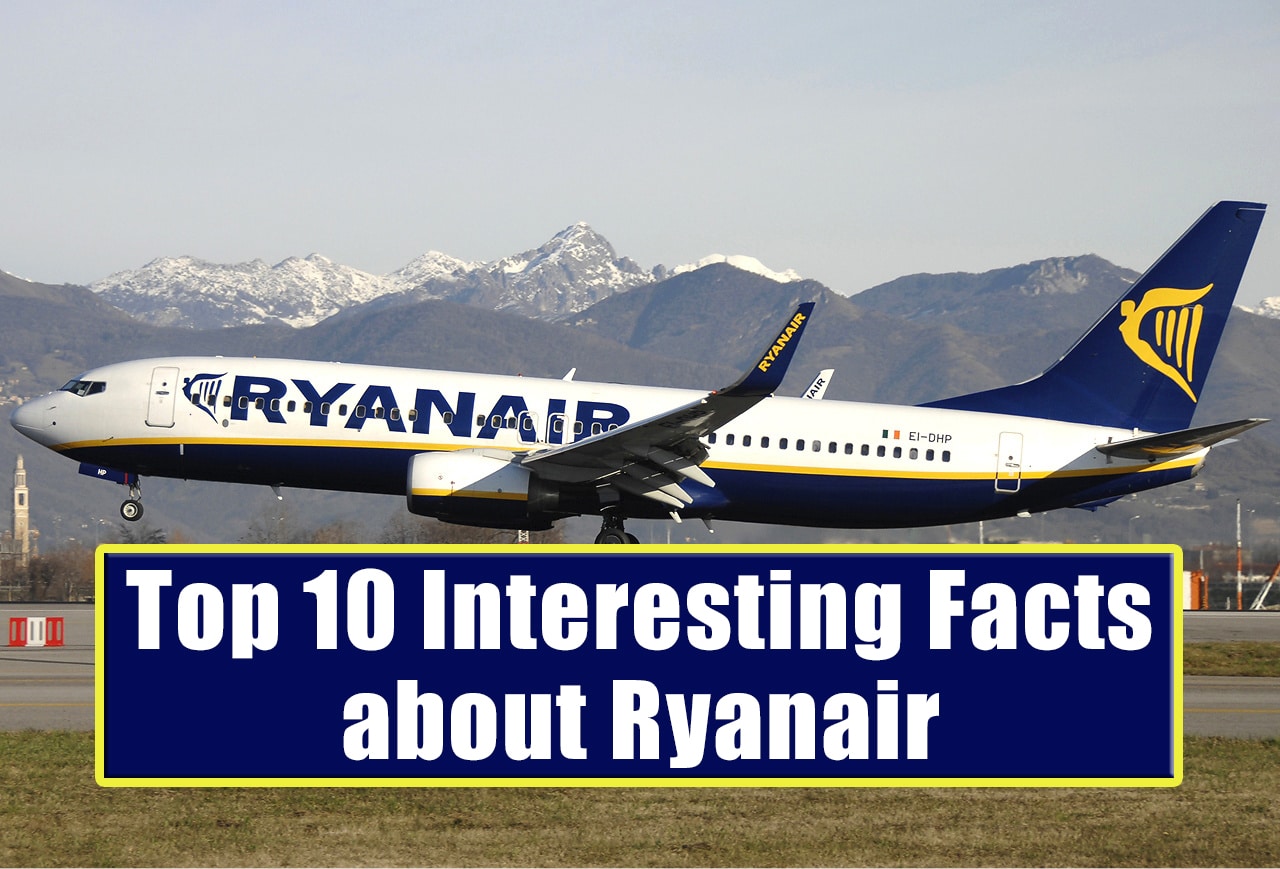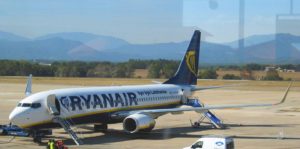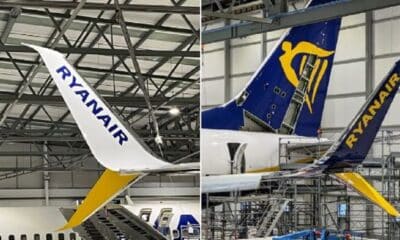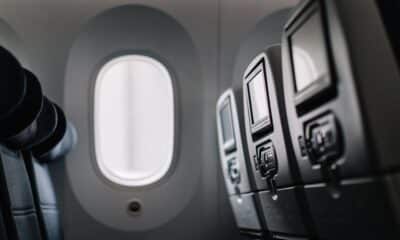Aerospace
Top 10 Interesting Facts about Ryanair

Top 10 Interesting Facts about Ryanair: Ryanair is one of Europe’s largest and successful low-cost carrier airline groups. Ryanair is the parent company of Ryanair UK, Buzz, Malta Air & Lauda as sister airlines.
1. Ryanair started with a share capital of just £1
Ryanair established in the year 1984 by the Ryan family as “Danren Enterprises” with a share capital of just £1 and a staff of 25. It was shortly thereafter renamed “Ryanair” (after Tony Ryan). It started operations in 1985 flying a 15-seat Embraer Bandeirante turboprop aircraft between Waterford and Gatwick Airport.
2. Ryanair starts the first fare war in Europe.
In 1986 Ryanair obtains permission from regulatory authorities to lower the fare price between the Dublin-London route. The launch fare price was £99, which was half the price set by British Airways and Aer Lingus’, later both BA and Aer Lingus slashed their high prices in response to Ryanair’s.
Over the next few years, Ryanair started new routes to other places of Europe such as Stockholm, Brussels, and Paris with 80% low airfares compared to other airlines.
3. No frill, No business class, and single model aircraft.
Ryanair started with the “No frill, No business class, and single model aircraft” principle. New Ryanair aircraft have been delivered with non-reclining seats, no seat-back pockets, safety cards stuck on the back of the seats, and life jackets stowed overhead rather than under the seat. This allows airlines to save on aircraft costs and enables faster cleaning and security checks during the short turnaround times. Ryanair is committed to providing low airfares, this means you have little legroom, have to pay for extra luggage, food, or seat reservations.
4. Ryanair operates the largest no, of Boeing 737 fleet in the world
Ryanair group carried 149m annual customers on more than 2,500 flights per day from 79 bases across Europe and North Africa, the Group connects over 242 airports, operates over 1,800 routes in 40 countries on a fleet of 430 Boeing 737-800 and 29 Airbus A320 aircraft, 270 of them belongs to Ryanair alone, with a further 210 Boeing 737 on order. Which will enable the Group to lower fares and grow traffic to 200m p.a. over the next 4 or 5 years.
5. Europe’s Eco-friendly Airline
Ryanair has a team of over 16,000 highly skilled aviation professionals delivering Europe’s No.1 on-time performance. The average age of the Ryanair fleet is approximately 8 years and is set to get younger with the latest aircraft order. Ryanair is Europe’s greenest cleanest airline group.
6. It is the world’s fourth-largest airline
As indicated by figures from worldwide carrier affiliation IATA, Ryanair conveyed 136.7 million travelers in 2019, behind just Southwest, Delta & American Airlines. It climbed a spot from its fifth spot in 2016, jumping China Southern, which lost its place in the top five to United.
7. A Ryanair aircraft takes off every 45 seconds
Over a normal day, the carrier’s fleet travels somewhere in the range of 382,605 km, as per the airline, visiting 40 nations on 350 aircraft. Research a year ago discovered that a Ryanair airplane flew 46 flights in seven days, to 19 goals, timing up 45,586 km.
Read more :
8. Ryanair launched its own website to cut down travel agents’ fees.
Two 17-year-old understudies’ students were appointed by Ryanair in 2000 to develop the airway’s first site. The airways were obviously cited £3.5million for the design and developments of its online nearness, so they rather moved toward two young people, John Beckett and Tom Lenihan, who carried out the responsibility for around £20,000 to develop Ryanair first site.
9. Ryanair has never had an accident
In 35 years of flying, the closest the carrier has come to a serious accident was On 10 November 2008, Ryanair Flight 4102, from Frankfurt–Hahn Airport, suffered undercarriage damage in an emergency landing at Rome–Ciampino Airport, after experiencing bird strikes, which damaged both engines on approach. Two crew members and eight passengers were taken to hospital with minor injuries.
10. Free Publicity
Ryanair is also known for their provocative advertising, such as deliberately courting controversy to generate free publicity for the airline, have led to a number of complaints to the Advertising Standard Authority (ASA) and occasionally court action being taken against the airlines. Ryanair often uses advertising to make direct comparisons and attack its competitors. One of its advertisements used a picture of the Manneken Pis, a famous Belgian statue of a urinating child, with the words: “Pissed off with Sabena’s high fares? Low fares have arrived in Belgium.” Sabena sued and the court ruled that the advertisements were misleading and offensive. Court-ordered Ryanair to discontinue the advertisements immediately or face fines. Another provocative ad campaign headlined “Expensive BAstards!” compared Ryanair with British Airways price comparisons, but this time court sided with Ryanair.

A Ryanair Boeing 737-800 displaying “bye bye Latehansa” livery referring to German competitor Lufthansa in 2008.
A Ryanair Boeing 737-800 displaying “bye bye Latehansa” livery referring to German competitor Lufthansa in 2008.
In addition, Ryanair has been calling for better customer service since last year, as they regularly performed poorly in customer satisfaction surveys. For many, this may be just one more reason to book Ryanair.

Aerospace
Which is bigger 777x or 787 aircraft ?

The 777X is a new series of the Boeing 777 family and is designed to be larger and more efficient than its predecessor. It features two variants: the 777-8 and the 777-9, being the larger of the two.
The Boeing 777X emerges as the larger sibling within the Boeing family, representing a significant leap forward in both size and efficiency. Comprising two variants, the 777-8 and the 777-9, the latter takes the crown as the larger of the two. With its expansive fuselage and impressive wingspan, the 777X is tailored for long-range journeys and boasts a substantial passenger capacity.
On the other hand, the Boeing 787, affectionately known as the Dreamliner, occupies a niche in the market as a smaller yet formidable aircraft designed for medium to long-range flights. Its distinguishing feature lies in its composite fuselage, a technological marvel that renders it lighter and more fuel-efficient compared to conventional aluminum counterparts. The Boeing 777X is larger than the Boeing 787 aircraft.
When it comes to passenger capacity, the 777-9 reigns supreme, typically accommodating a sizeable contingent of 400-425 passengers in its standard configuration. In contrast, the 787, with its more modest dimensions, typically carries between 240-290 passengers, depending on the variant and layout.
One of the remarkable innovations introduced with the 777X is its folding wingtips, a feature designed to address the logistical challenges of accommodating such a large aircraft in conventional airport gates. These folding wingtips enable the 777X to retract its wings, allowing it to fit into gates designed for smaller aircraft while still reaping the benefits of an extended wingspan during flight, thereby enhancing fuel efficiency and operational flexibility
Aerospace
China Secures Production Certificate for Mass Production of Pilotless eVTOL Aircraft

The first passenger-carrying pilotless electric vertical takeoff and landing (eVTOL) aircraft in the world, the EH216-S, has received the Production Certificate for its eVTOL aircraft from the Civil Aviation Administration of China (CAAC).
This is a significant milestone for EHang Holdings Limited, the leading UAM technology platform company in the world. This outstanding accomplishment is another big step towards mass manufacturing for the eVTOL aircraft and the ensuing commercial operations, building on the ground-breaking acquisition of the Type Certificate and the Standard Airworthiness Certificate for the EH216-S.
The PC is a crucial certificate that the aircraft maker receives from the CAAC, the country’s aviation authority. By obtaining this certificate, EHang has demonstrated that it has set up a quality management system for mass production that satisfies the airworthiness regulation standards set forth by the CAAC, and the company has been given permission to continue producing mass quantities.
It is also a strong guarantee of the calibre of the goods made by EHang. Raw materials, supplier management, manufacturing organisation, production quality control, aircraft pre-delivery test, after-sales repair and maintenance, etc. are all included in the mass production quality management system for the EH216-S.
To ensure that every aircraft and its components that roll off the production line strictly adhere to the approved type design and safety requirements, the system sets clear guidelines and documentation for every step in the production procedure. This ensures comprehensive traceability and safety control.
Aerospace
Four Airbus A380 Superjumbos lined up to be scrapped

In a strategic move aimed at reclaiming valuable resources from the iconic Airbus A380 aircraft, VAS Aero Services and Dr. Peters Group have announced a significant collaboration.
This partnership marks a milestone in aviation logistics and aftermarket services, with four of these colossal planes slated for teardown and redistribution of used serviceable material (USM).
The venture between VAS Aero Services, renowned for its expertise in aircraft dismantlement, and Dr. Peters Group, a prominent Germany-based investment fund management firm, underscores a commitment to sustainable aviation practices. This isn’t their first foray into scrapping A380s; their successful partnership has already seen the dismantlement of these aircraft, making them pioneers in this niche.
Under the agreement, the latest consignment brings the tally to eight A380s entrusted to VAS by Dr. Peters Group. Managing Director Christian Mailly of Dr. Peters Group emphasized the trust placed in VAS, citing their unparalleled capabilities in dismantlement and aftermarket sales network. It’s a strategic move in response to the growing demand for quality USM parts, particularly with the resurgence in reliance on the A380.
Notably, the teardown process will be carried out at various locations, optimizing the positioning of harvested parts to cater to different markets. While some parts will be positioned in Europe to support operators in the region and the Middle East, others will remain in the Asia-Pacific region. This meticulous strategy ensures efficient access to spare parts, benefiting MROs and airlines across these markets.
The decision to retire these A380s comes at a time when operators are reassessing fleet strategies amidst evolving market dynamics. Despite initial plans for quick retirement due to the emergence of more fuel-efficient alternatives, factors such as a rebound in long-haul demand and delays in new widebody deliveries have prompted operators to reconsider. The A380, with its unique capacity and capabilities, presents a practical solution for short-term capacity management.


























